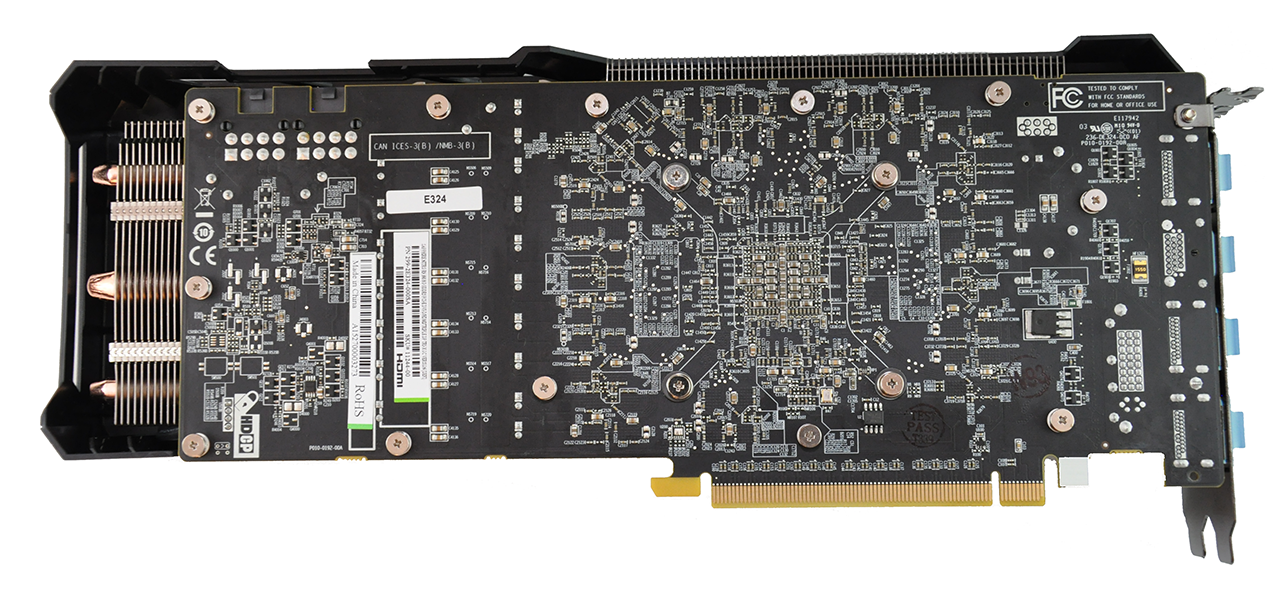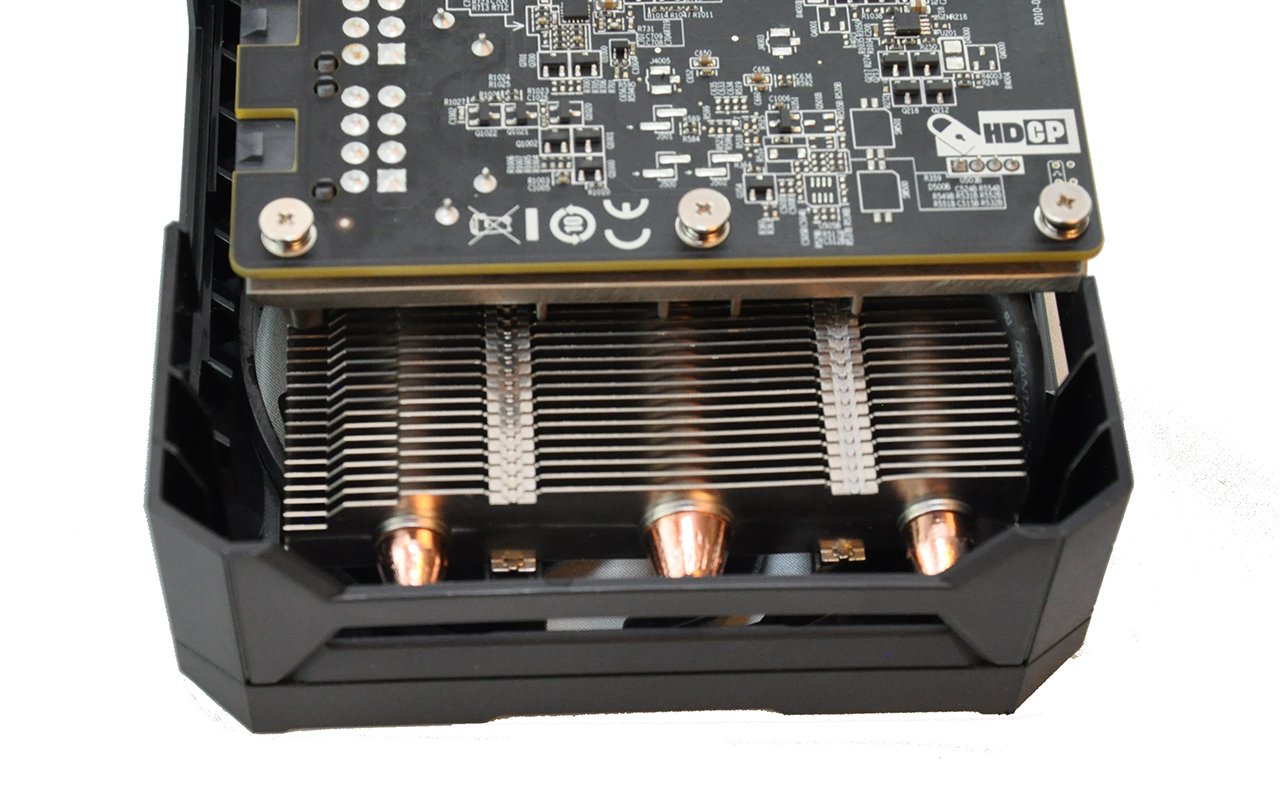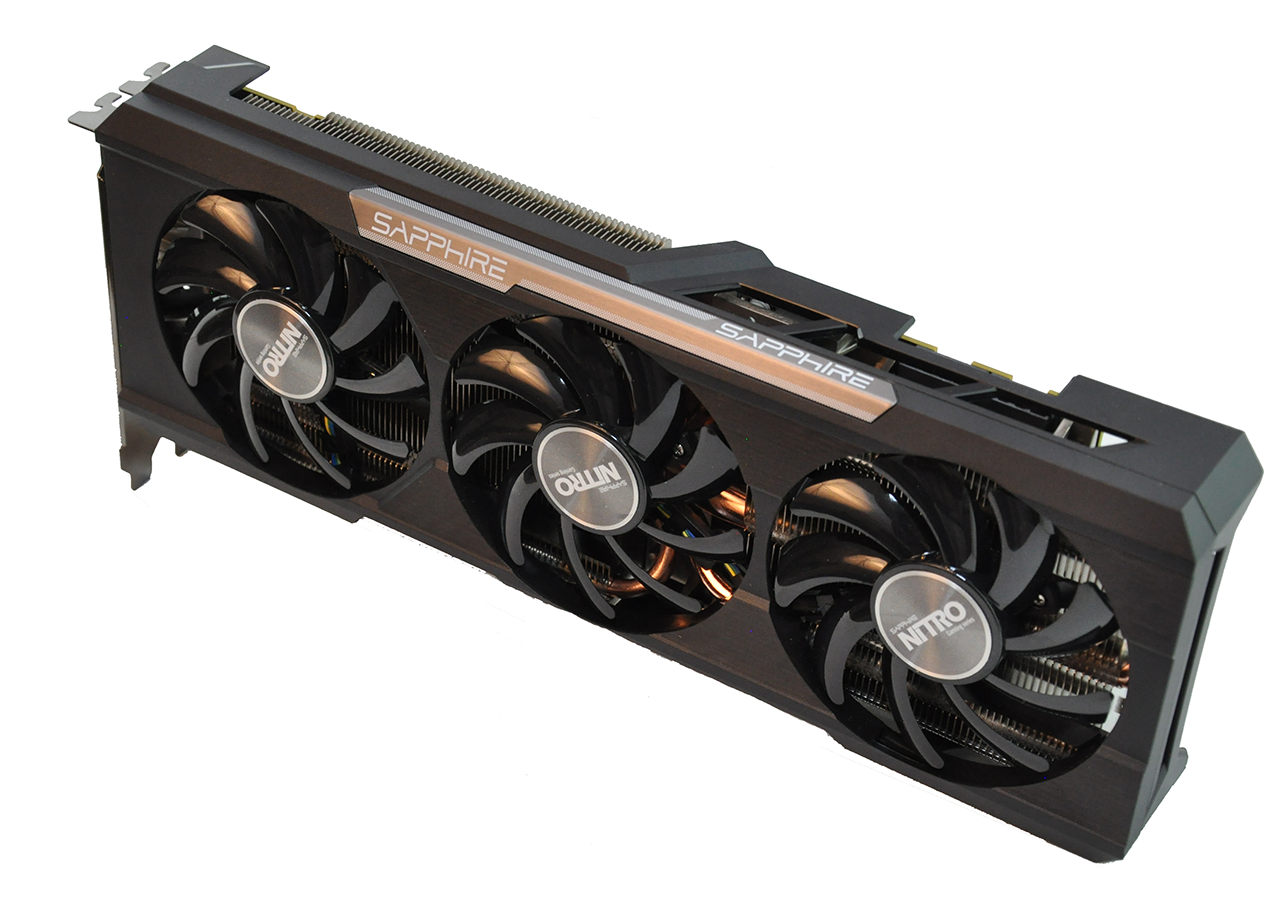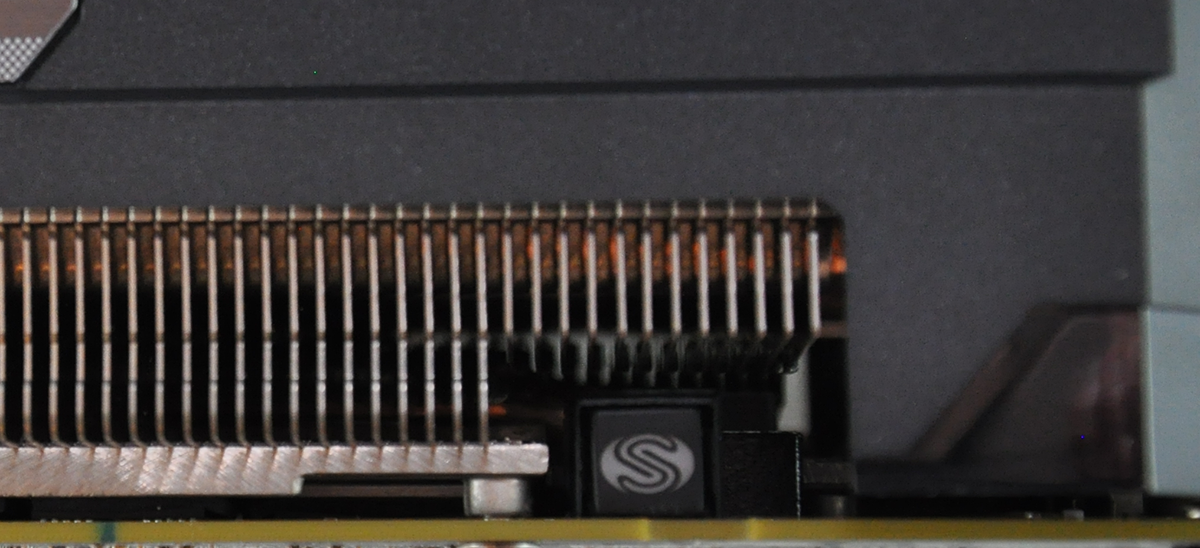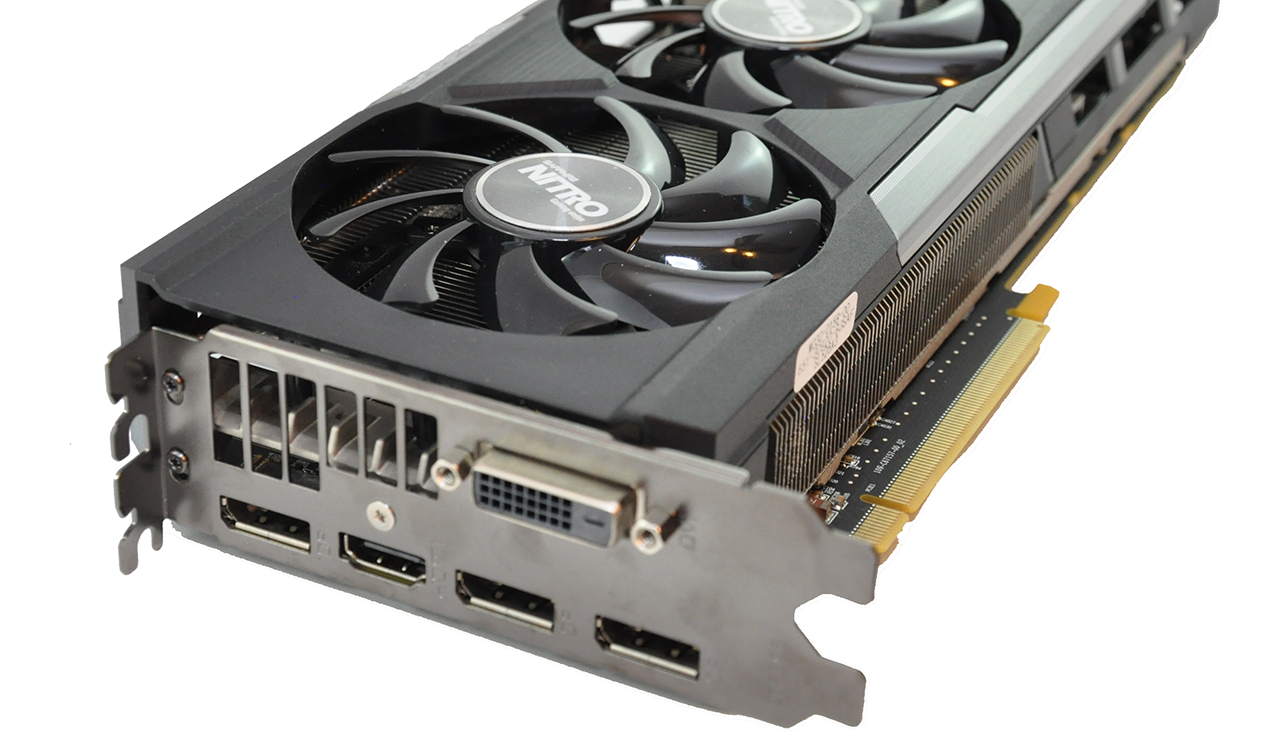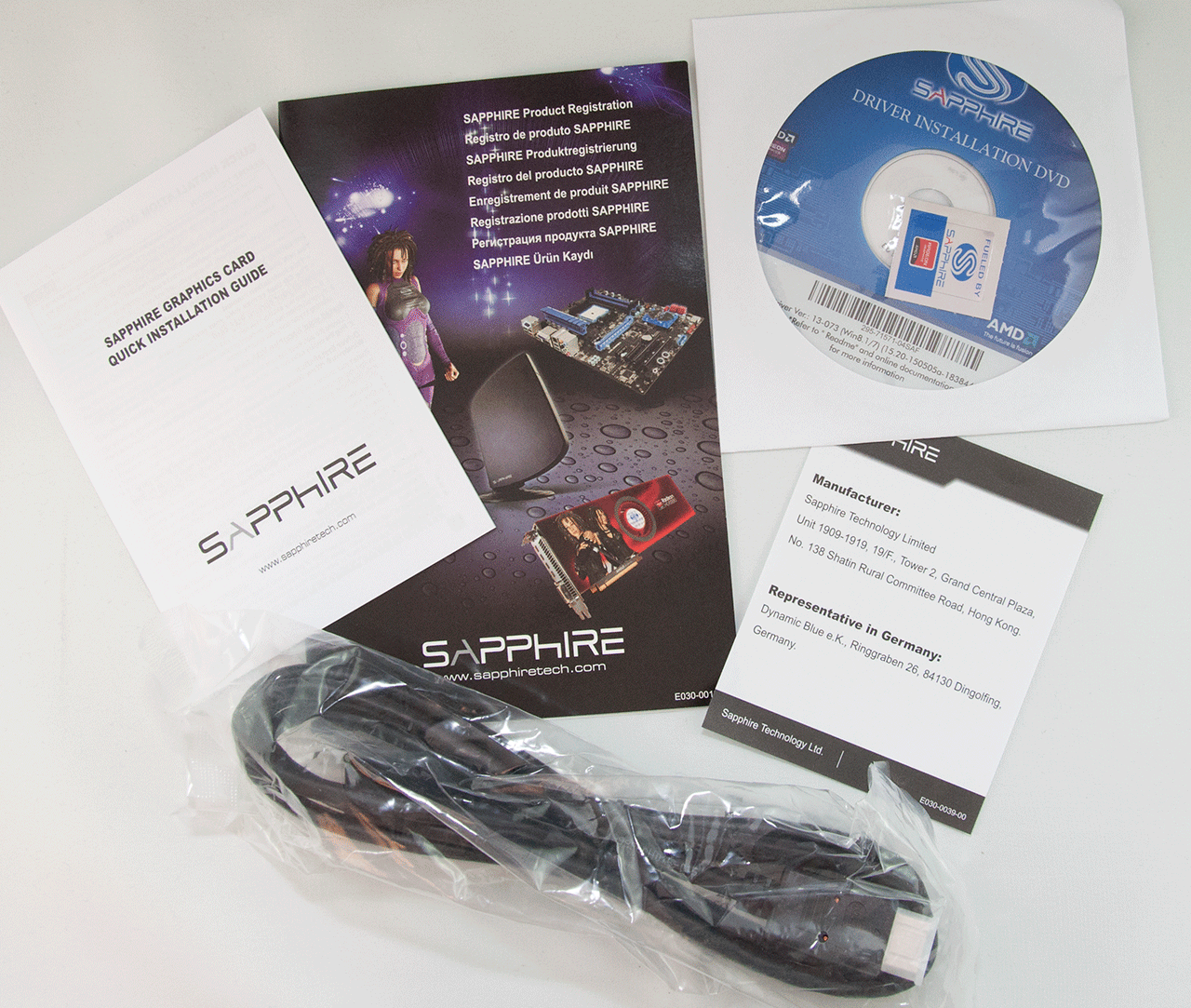Sapphire Nitro R9 390 8G D5 Review
With all of the focus on AMD’s Fury and its HBM, there isn't much attention being paid to the more affordable Radeon R9 390. Is it possible that we missed a gem?
Why you can trust Tom's Hardware
Product 360
At first glance, Sapphire’s Nitro R9 390 8G D5 looks similar to the Fury Tri-X I reviewed recently. It features a similar shape and size. In fact, it also employs a Tri-X cooler without the added colors. The Nitro edition card features a much subtler black color scheme with grey and silver accents, which will be easier to match with other components.
The card's heat sink extends nearly an inch past the back of the PCB, and features five copper heat pipes passing through vertical aluminum fins. Two of the heat pipes are 6mm, two are 8mm and the one going through the center out the back is 10mm. Each pipe starts at the copper contact plate and comes out of the fins under the central fan. The two 6mm pipes loop back through the fins over the GPU, while the remaining three carry on to the rear section of fins. Sapphire claims this setup creates up to 300W of cooling capacity.
To cool off the fins and the heat pipes, Sapphire includes three 90mm dual ball-bearing fans. The company says its dual bearing design is made to keep dust out and ensure a long lifetime. Sapphire also implements Intelligent Fan Control II, which allows individual fans to stop spinning, cutting down on noise when extra airflow isn't needed.
Unlike the Fury that Sapphire sent us, the R9 390's PCB is rather long. Not counting its bracket, the circuit board measures 10.5 inches (267mm) long. When you count the shroud's full length, though, it's 12 inches (395mm) long without the bracket. Or, add 15mm to count the bracket. At the thickest point (from shroud to rear screw), the R9 390 Nitro measures 45mm. It would be a tight squeeze to fit two of these side by side.
The board itself comes equipped with 16K-hour capacitors that use high-polymer aluminum. According to Sapphire, these caps offer superior lifespan over standard aluminum caps. Sapphire also uses what it calls Black Diamond Chokes, which the company claims are 10% cooler and 25% more power efficient than normal chokes.
Along the top edge of the card, you’ll find a pair of eight-pin power connectors. AMD did away with its CrossFire connectors, instead sending multi-GPU data across the PCIe bus. Instead, you'll find a BIOS selection switch along the top edge.
By default, the card comes with its legacy BIOS enabled, but pressing the button switches it to the digitally-signed UEFI. In that mode, boot and resume times should be quicker.
Get Tom's Hardware's best news and in-depth reviews, straight to your inbox.
You get several video output options. Similar to the way Nvidia's newest cards are arranged, Sapphire’s Radeon R9 390 Nitro Overclocked exposes three DisplayPort connections, a single DVI-I port and HDMI. The card can output through as many as four of its connectors simultaneously.
Sapphire’s packaging keeps the card safe while still showing it off through a small plastic window in the box. Because of this, the card isn't in an anti-static bag. It is, however, contained in soft foam on all sides, protecting it from impact. Inside the box, Sapphire includes an HDMI cable along with a driver disc and case badge. You’ll also find a quick-start guide and a pamphlet about Sapphire products.
Kevin Carbotte is a contributing writer for Tom's Hardware who primarily covers VR and AR hardware. He has been writing for us for more than four years.
-
youcanDUit great review. i have a question about AMD and project vulkan. do AMD cards benefit from vulkan, like they do (did) from project mantle with the GCN1.1+? also it was said that implementing different multi card setup on DX 12 is harder than anticipated, is project vulkan capable of such feat?Reply -
uglyduckling81 It's good to see competition so close. It does beg the question as to why hardware several years old is still leading the charge.Reply
Both companies seem to be in a bit of a pit. Hopefully the new manufacturing node size will gets things going again.
I am pretty happy with my GTX970 though. It's a nice card. -
Taintedskittles I m so torn between getting a 390 or gtx970. (1st world problems)Reply
If amd gvr were as good as shadowplay it wouldn't be a contest. But shadowplay is only a 1-2 fps hit compared amd gvr 10-20fps loss. The gtx 970 uses about 100w less than the 390 under load. But the 390 has better specs on paper & seems more future proof. Plus I m worried I'd be stretching my 650w psu with the 390.
sigh.....
note: using hd7870, Ive tried out gvr & its horrible, currently using dxtory & obs. -
VaporX Tainted, GVR options abound that great features. I have used OBS with some really neat overlay options and Raptr has a solid set of features as well.Reply
As for the PSU, you should be just fine. I run a Nitro 390 on my demo rig and do so with a 450 watt PSU and no issues. In fact at gaming load I have not yet seen the computer push over 400 watts total power load.
Under typical gaming loads the 390 pulls about 80 watts more power. Our cooling solution means this is not a heat issue as we easily handle any heat generated by the card. 80 watts equates to nothing in power usage over typical gaming sessions. Assuming 8 hours per day, every day it would mean a difference at the end of the year of about $25 in extra electric charges. -
Daniel Ladishew Why is the 980 missing from so many of these charts? There should be a 3rd party OC 980 (not the reference) in every chart if your really wanting to compare price/performance across these options. Is this on purpose to make the 390 look better or a lack of comprehensive testing?Reply -
MrVic87 I've been holding out a while to upgrade my GTX 760. Truthfully, I've been patiently waiting to see what Nvidia is going to come up with to counter the AMD 300 cards. Each article I've read, each video benchmark I've watched, just shows the same result, the 390/390x cards outperforms the 970/980! Not by much but it's noteworthy. I guess my money is truly going for the red brand this time around.Reply -
kiniku ReplyI've been holding out a while to upgrade my GTX 760. Truthfully, I've been patiently waiting to see what Nvidia is going to come up with to counter the AMD 300 cards. Each article I've read, each video benchmark I've watched, just shows the same result, the 390/390x cards outperforms the 970/980! Not by much but it's noteworthy. I guess my money is truly going for the red brand this time around.
"Not by much but noteworthy." LOL How does that work? But sure if you'd like your rig having to draw and dispense 100+ watts of internal heat for 3-5 more noteworthy FPS then knock yourself out.
-
plasmastorm Got myself an MSI 390 to replace my evga 660ti 3gb. Holy poo what an upgrade !Reply
Was running stupidly hot at 84c for a week but then noticed that was due to the game, Mech warrior online using dx 11 which has known issues on a lot of cards, not just AMD.
More than happy with it and happily clocks to 1720 core with an 83% asic

